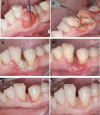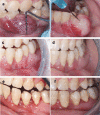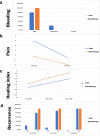Diode laser versus sclerotherapy: bloodless approaches in the treatment of oral pyogenic granuloma (randomised controlled clinical trial)
- PMID: 36307616
- PMCID: PMC10020281
- DOI: 10.1007/s10266-022-00759-9
Diode laser versus sclerotherapy: bloodless approaches in the treatment of oral pyogenic granuloma (randomised controlled clinical trial)
Abstract
Oral pyogenic granuloma (PG) is traditionally treated by surgical excision which is associated with bleeding, pain and a high rate of recurrence. Our research aimed to clinically assess the effectiveness of diode laser versus sclerotherapy, as bloodless approach, in the treatment of oral PG. We randomly divided 20 patients with oral PG into two groups, with those in the test group being managed via diode laser application and those in the control group via injections of ethanolamine oleate as a sclerosing agent. All patients were evaluated intraoperatively for bleeding severity and postoperatively for pain. The quality of healing was also assessed using Landry healing index after the 1st, 2nd and 4th weeks. Additionally, the patients were recalled after 3, 6 and 9 months from the end of treatment for recurrence evaluation. Our results revealed that intraoperative bleeding did not differ significantly between both groups while postoperative pain decreased significantly in the sclerotherapy group compared to the laser group. For different intervals, the sclerotherapy group had a higher healing quality index than the laser group, although the difference was not statistically significant. However, recurrence occurred in the laser group, there were no cases of recurrence in the sclerotherapy group in all intervals. In conclusion, diode laser treatment of PG is a reliable, less invasive, and sensitive procedure that requires an experienced operator and specialised equipment. However, ethanolamine oleate sclerotherapy is an inexpensive, simple technique besides being less prone to recurrence problems, especially when treatment duration is not a concern.
Keywords: Diode laser; Ethanolamine oleate; Oral pyogenic granuloma; Sclerotherapy.
© 2022. The Author(s).
Conflict of interest statement
The authors declare that they have no competing interests.
Figures



Similar articles
-
Management of oral pyogenic granuloma with sodium tetra decyl sulphate. A case series.N Y State Dent J. 2013 Jun-Jul;79(4):55-7. N Y State Dent J. 2013. PMID: 24027901
-
Sclerotherapy: a novel bloodless approach to treat recurrent oral pyogenic granuloma associated with port-wine stain.Ann Vasc Surg. 2014 Aug;28(6):1564.e9-14. doi: 10.1016/j.avsg.2014.01.009. Epub 2014 Feb 6. Ann Vasc Surg. 2014. PMID: 24509379
-
Comparative Evaluation of Efficacy and Safety of the Diode Laser (980 nm) and Sclerotherapy for the Treatment of Oral Pyogenic Granuloma.Int J Dent. 2022 Sep 17;2022:8269221. doi: 10.1155/2022/8269221. eCollection 2022. Int J Dent. 2022. PMID: 36164597 Free PMC article.
-
Sclerotherapy versus sham or no intervention for primary prophylaxis of oesophageal variceal bleeding in children with chronic liver disease or portal vein thrombosis.Cochrane Database Syst Rev. 2020 Mar 5;3(3):CD011573. doi: 10.1002/14651858.CD011573.pub2. Cochrane Database Syst Rev. 2020. PMID: 32133620 Free PMC article.
-
Clinical inquiries. What's the best treatment for pyogenic granuloma?J Fam Pract. 2010 Jan;59(1):40-2. J Fam Pract. 2010. PMID: 20074501 Review. No abstract available.
Cited by
-
Comparison of the efficacy and adverse effects of long pulsed 1064 nm Nd: YAG laser and sclerotherapy in the treatment of pyogenic granuloma in children: a retrospective study.Sci Rep. 2025 Jan 22;15(1):2843. doi: 10.1038/s41598-025-85401-8. Sci Rep. 2025. PMID: 39843523 Free PMC article.
-
Excision of Pyogenic Granuloma (PG) With Diode Laser on the Lower Lip in an Unusual Location: A Case Report.Cureus. 2023 Aug 29;15(8):e44319. doi: 10.7759/cureus.44319. eCollection 2023 Aug. Cureus. 2023. PMID: 37779795 Free PMC article.
References
-
- Chi AC, Neville BW, Damm DD, Allen C. Oral and maxillofacial pathology-E-Book. Amsterdam: Elsevier Health Sciences; 2017.
-
- Regezi J, Sciubba JJ, Jordan RCK. Oral Pathology, clinical pathologic correlation. 4. Philadelphia: Sanders Company; 2003.
Publication types
MeSH terms
Substances
LinkOut - more resources
Full Text Sources

